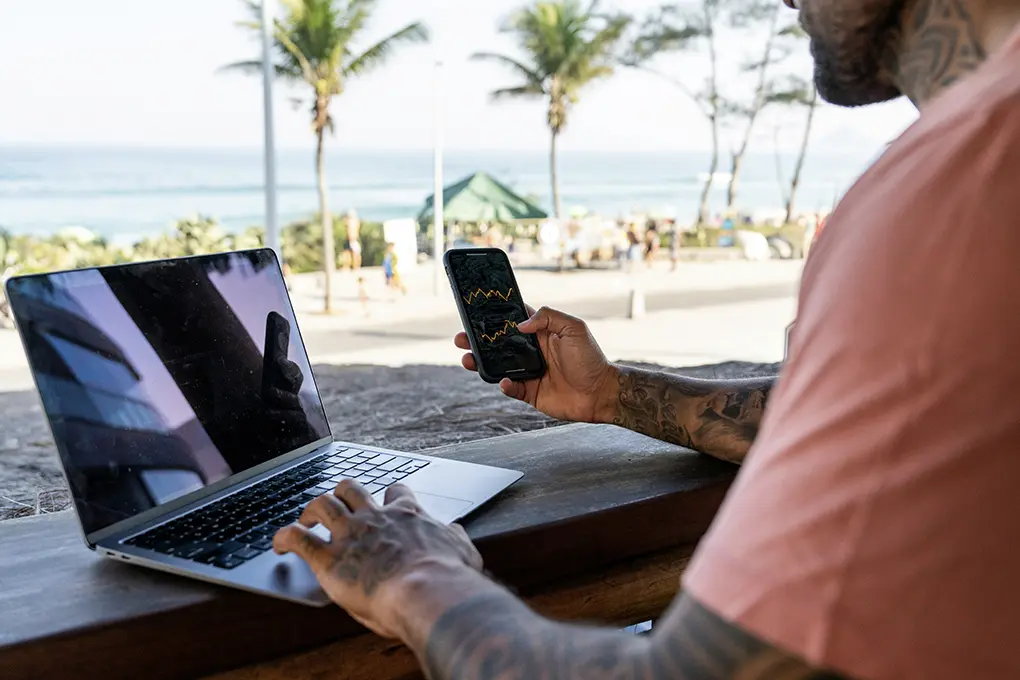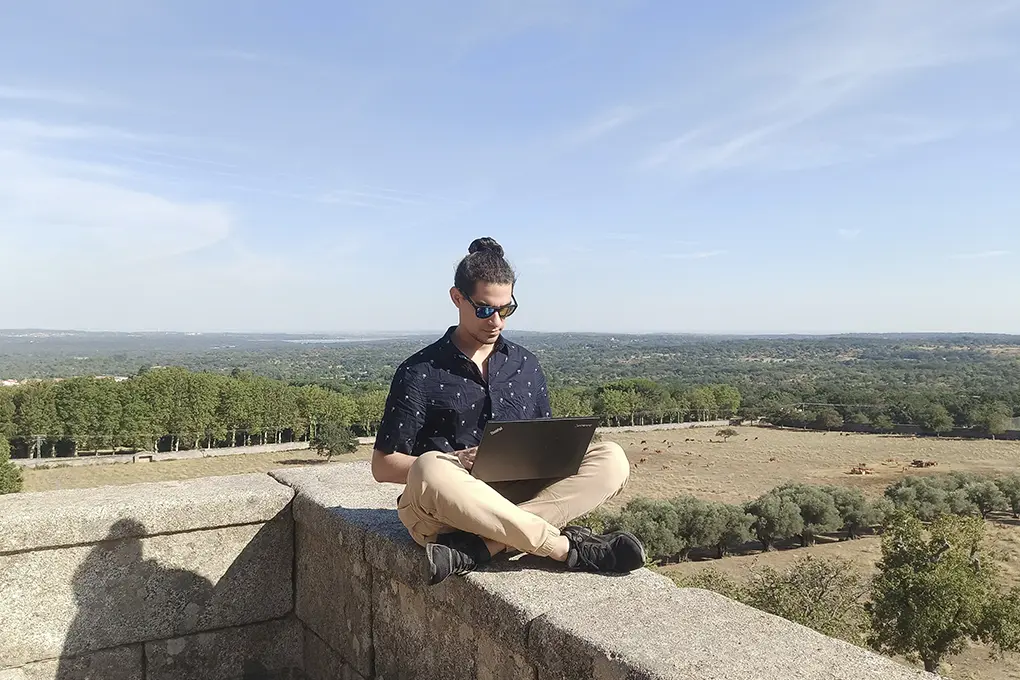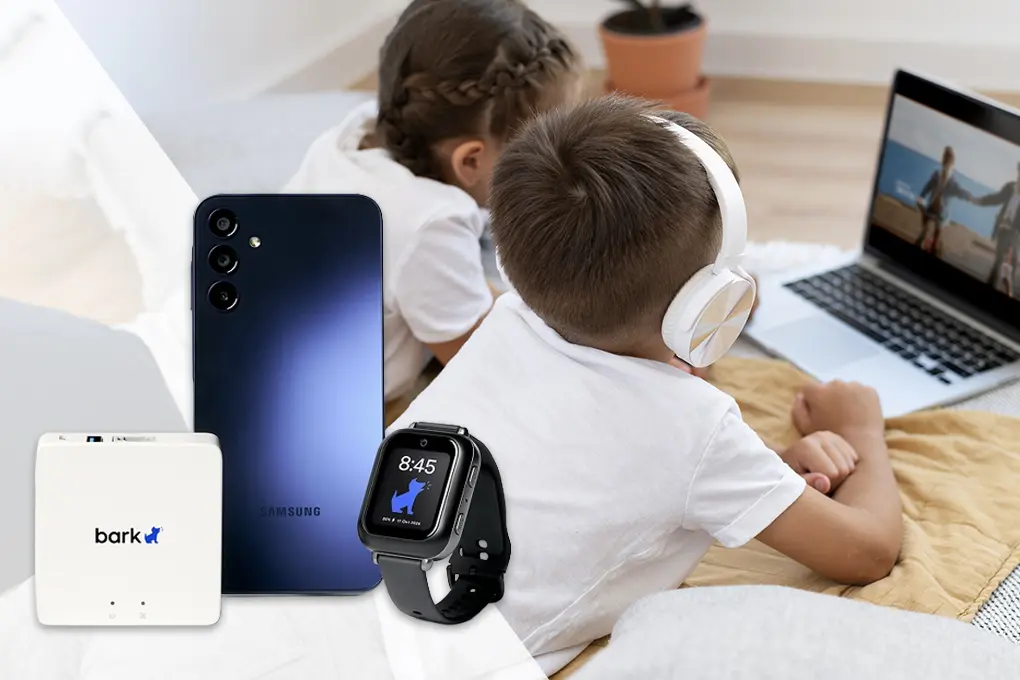Working remotely while exploring the world offers unprecedented freedom, but it also introduces unique digital security challenges. From unsecured public Wi-Fi networks to physical device theft, digital nomads face risks that traditional office workers don’t typically encounter.
According to a recent IBM Security study, travelers are three times more likely to be targeted by cybercriminals than the average internet user, making proper protection essential for anyone working on the road.
Even more alarming is that only 40% of those who responded believed that they were at increased risk when traveling, but up to 70% engaged in online behavior that put them at risk of cyber threats.
Quite telling is that as many as 40% of people who use public Wi-Fi networks had their personal data compromised, according to a recent study conducted by Forbes.
As someone who’s logged thousands of hours securing connections from beach cafés to airport lounges, I’ve learned that having the right cybersecurity is about protecting your livelihood and personal data. The essential tools discussed here today will help you maintain a secure digital perimeter no matter where your adventures take you.
Table of Contents
- Key Takeaways
- Why Digital Nomads Need Special Security Considerations
- Essential Software Tools for the Traveling Professional
- Hardware Security Tools for Safe Global Travel
- A Quick Glance at the Best Cybersecurity Tools for Digital Nomads
- Best Practices to Complement Your Security Toolkit
- Assembling Your Custom Digital Nomad Security Kit
- When to Upgrade Your Security Toolkit
- My Personal Experience With These Digital Nomad Cybersecurity Tools
- Conclusion: Security Is Freedom for Digital Nomads
- Frequently Asked Questions
Key Takeaways
- Digital nomads face higher cybersecurity risks due to frequent use of public Wi-Fi and international travel.
- VPNs are essential for encrypting traffic and protecting data on unsecured networks.
- Password managers and identity theft protection tools help secure login credentials and personal information.
- Hardware tools like privacy screens, RFID-blocking wallets, and security keys offer critical physical protections.
- Cloud backup services ensure that your data is safe and retrievable after device theft or ransomware attacks.
- Best practices like pre-travel checklists and device compromise plans are just as important as the tools themselves.
Why Digital Nomads Need Special Security Considerations
The nomadic lifestyle comes with specific security challenges that don’t affect traditional remote workers. When you’re connecting through hotel networks in Bangkok one week and a café in Barcelona the next, your digital footprint becomes significantly more vulnerable.
Digital nomads regularly face challenges like government surveillance in certain countries, insecure public Wi-Fi, border checkpoints where devices might be searched, and physical security concerns in shared workspaces.
According to High Speed Internet, up to 20% of people use unsecured public Wi-Fi to work remotely, with up to 47% using public Wi-Fi regularly. Furthermore, according to Norton, up to 60% of people log into their email accounts on public Wi-Fi, putting them at great risk.
Also, Statista notes that roughly 25% of Americans had information and data breaches occur when using public Wi-Fi at restaurants and cafes, with airports and hotels also posing major risks—all places that digital nomads frequent. The cost of a personal data breach increased by 10% from 2023 to 2024, and the cost increases continue into 2025.
- “The biggest mistake I see among traveling professionals is treating security as an afterthought rather than building it into their workflow from day one,” says Kurt Sanger, cybersecurity expert at Batten Cyber. “By the time you realize you’ve connected to a compromised network, your data may already be exposed.”
Before discussing the specific tools you need, it’s worth understanding that no single solution offers complete protection. The most effective approach combines software tools, hardware solutions, and security-conscious behaviors.
Let’s look at the essential components of a comprehensive digital nomad security toolkit.
Essential Software Tools for the Traveling Professional
VPNs, password managers, and identity theft protection services are all essential software tools that protect you when traveling.
1. Virtual Private Network (VPN) – Your Digital Shield Abroad
A reliable VPN is perhaps the most crucial tool in any digital nomad’s arsenal. VPNs create an encrypted tunnel for your internet traffic, preventing snooping on public Wi-Fi and helping you access geo-restricted content or services. Shockingly, only 20% of users employ a VPN for protection, an extremely low number considering ever-growing cyber threats.
When selecting a VPN for travel, prioritize these features:
- Wide server coverage across countries you plan to visit
- Strong encryption standards (OpenVPN or WireGuard protocols)
- A strict no-logs policy
- Kill switch functionality to prevent data leakage if the VPN disconnects
- Multi-device support for all your gadgets
NordVPN is an excellent choice for travelers due to its extensive global server network, reliable performance in countries with restrictive internet policies, and additional security features like double VPN encryption for extra-sensitive work.
What sets it apart from competitors is its consistently fast speeds even when connecting to distant servers, which is crucial when you’re trying to join video calls from halfway around the world.
Remember to install and test your VPN before departure, as some countries block VPN provider websites, making it difficult to download once you’ve arrived.
2. Password Manager – Your Digital Vault
Working across multiple time zones often means logging into work platforms at unusual hours and from unfamiliar locations. This can trigger security alerts or, worse, tempt you to use simpler passwords for convenience.
A strong password manager solves these problems by:
- Generating and storing complex, unique passwords for each service
- Auto-filling credentials securely across devices
- Storing secure notes for sensitive travel information
- Offering biometric authentication options
Look for password managers with offline access capabilities, allowing you to retrieve your passwords even without an internet connection, a lifesaver when traveling to remote locations. Many leading options also include secure document storage for digital copies of your passport, travel insurance, and other crucial documents.
For digital nomads requiring cross-device syncing and travel-friendly features, 1Password’s password manager offers an ideal combination of security and convenience, with its travel mode that allows you to temporarily remove sensitive data from your devices when crossing borders.
The use of password managers has grown from 21% in 2022 to 34% in 2023, illustrating the increasing awareness that stronger security measures are needed, as many are still left unprotected on this front.
3. Identity Theft Protection Service – Your Personal Security Guard
The nomadic lifestyle increases exposure to identity theft risks, from physically losing credit cards to having personal information compromised through unsecured networks. The FTC reported that Americans lost over $5.8 billion to fraud in 2021, a 70% increase from the previous year, with travelers being particularly vulnerable.
A comprehensive identity theft protection service monitors:
- Your credit reports for suspicious activity
- Dark web mentions of your personal information
- Unauthorized use of your identity for new accounts
- Financial transactions that appear unusual
Many services also include identity theft recovery assistance, which is invaluable when you’re thousands of miles from home. Some providers offer international coverage and support, which is critical for those spending significant time abroad.
Services like Aura’s all-in-one protection platform include VPN capabilities alongside identity monitoring, creating a more comprehensive total digital security solution that’s particularly valuable for frequent travelers.
4. Secure Cloud Backup Solution – Your Data Insurance Policy
Device theft is a real concern for digital nomads. According to Kensington, a laptop is stolen every 53 seconds, with theft rates higher in transportation hubs and tourist areas frequented by travelers. Beyond physical loss, ransomware attacks can lock you out of your files when you’re far from technical support.
An encrypted cloud backup solution ensures:
- Your data remains accessible even if your device is lost or stolen
- Automatic backups occur whenever you connect to Wi-Fi
- Files are encrypted before leaving your device
- Version history allows recovery from ransomware attacks
When selecting a backup service, prioritize those offering end-to-end encryption (where you control the encryption keys) and the ability to set bandwidth limits for when you’re on metered connections. Services with selective sync can help you manage limited storage on travel laptops while keeping everything backed up.
Hardware Security Tools for Safe Global Travel
Just like there are various software tools that you can use to protect yourself while travelling, so are there various hardware security tools, including privacy screen filters, portable security keys, and RFID-blocking wallets.
Here are the most important pieces of hardware security you need for safe global travel.
5. Privacy Screen Filter – Your Visual Firewall
Open workspaces and crowded transportation create perfect opportunities for visual hacking, where someone simply looks over your shoulder to capture sensitive information. Privacy screens use microlouver technology to narrow the viewing angle of your display, making it appear dark to anyone not directly in front of it.
When selecting a privacy screen:
- Choose the correct size and aspect ratio for your specific device
- Consider removable models for situations where you want to share your screen
- Look for filters that also reduce blue light and protect your screen from scratches
Privacy screens are especially valuable when working in airplane seats, cafés, or co-working spaces where your screen might be visible to others. They’re a simple, low-tech solution that effectively prevents casual visual data theft.
6. Portable Security Key – Your Physical Authentication Factor
Two-factor authentication significantly improves account security, but SMS-based codes can be problematic when traveling internationally due to roaming issues or new SIM cards. Hardware security keys provide a physical authentication option that works regardless of your phone’s status.
These small USB devices:
- Provide phishing-resistant authentication
- Work with major services like Google, Microsoft, and social media platforms
- Don’t require batteries or cellular connection
- Can include additional functionality like encrypted storage
YubiKeys and Google Titan Security Keys are popular options that support multiple protocols. Consider getting at least two keys and storing one securely as a backup, as losing your only security key while traveling can create significant access problems.
7. Secure Portable Wi-Fi Hotspot – Your Personal Network Bubble
While VPNs encrypt your connection to unsecured Wi-Fi, having your own secure hotspot eliminates many risks altogether. Modern travel routers can create a secure wireless network using hotel ethernet connections or by serving as a cellular hotspot.
Look for devices that:
- Support VPN configurations at the router level (protecting all connected devices)
- Include built-in firewalls to block malicious traffic
- Offer long battery life for all-day work sessions
- Provide multi-device support for all your gadgets
Some advanced models even include features to detect network attacks or suspicious activity. These devices allow you to maintain consistent network settings across locations, reducing the need to connect to new networks and limiting your exposure to potentially compromised hotspots.
8. RFID-Blocking Wallet – Your Physical Data Shield
Digital security includes protecting physical items containing digital information—particularly credit cards and modern passports with RFID chips. These chips can potentially be read by nearby scanning devices without your knowledge.
RFID-blocking wallets and passport holders use materials that block radio signals, preventing unauthorized scanning.
Choose products that have been independently tested and verified to block relevant frequencies, as some products make claims they can’t back up with testing.
While the risk of RFID skimming is debated among security experts, these protective items offer an additional layer of security with minimal downside. That said, it is estimated that 2025 will see upwards of $4 billion in financial losses due to payment card skimming.
A Quick Glance at the Best Cybersecurity Tools for Digital Nomads
To provide you with a quick overview of the most important tools you should have in your security arsenal, here’s a table to reference.
| Security Tool | Best For |
| Virtual Private Network (VPN) | Encrypting internet traffic and protecting data on public Wi-Fi |
| Password Manager | Storing strong, unique passwords and secure documents across devices |
| Identity Theft Protection Service | Monitoring personal data for fraud and providing recovery assistance |
| Secure Cloud Backup Solution | Keeping data safe and accessible after theft, loss, or ransomware |
| Privacy Screen Filter | Preventing visual hacking in public workspaces or transit |
| Portable Security Key | Providing offline, phishing-resistant two-factor authentication |
| Secure Portable Wi-Fi Hotspot | Creating a private, encrypted network instead of using public Wi-Fi |
| RFID-Blocking Wallet | Protecting credit cards and passports from wireless skimming attacks |
Best Practices to Complement Your Security Toolkit

Having the right tools is essential, but how you use them matters just as much. Creating a pre-travel security checklist, developing a device compromise response plan and practicing safe public Wi-Fi use can all help keep your data protected while travelling.
Create a Pre-Travel Security Checklist
Before departing for a new destination, run through a security checklist:
- Update all operating systems and applications
- Enable full-disk encryption on all devices
- Back up all critical data
- Set up emergency contact information
- Research local cybersecurity laws and restrictions
For travelers visiting countries with significant internet restrictions or surveillance, additional preparation may be necessary. This might include setting up steganography tools to hide sensitive files or creating a minimal travel profile on your devices.
This cybersecurity for beginners guide can help ensure you haven’t overlooked fundamental security measures before heading to the airport.
Develop a Device Compromise Response Plan
Know what to do if you suspect your device or accounts have been compromised while traveling:
- Disconnect from the internet
- Change critical passwords using a secure, unaffected device
- Contact your identity protection service if available
- Enable additional verification requirements for financial accounts
- Document everything for potential insurance claims
Having this plan documented and accessible (perhaps in your password manager’s secure notes) prevents panic and improper responses that could make the situation worse.
Practice Public Wi-Fi Hygiene
Even with a VPN, practice good habits on public networks:
- Verify network names before connecting (ask staff for the correct network name)
- Disable auto-join for Wi-Fi networks
- Turn off file sharing and network discovery
- Use HTTPS websites exclusively
- Consider using your phone’s hotspot for sensitive tasks instead
Learning to manage your privacy online effectively becomes even more crucial when working from changing locations with variable security levels.
Assembling Your Custom Digital Nomad Security Kit
Every traveler has different needs based on their destination countries, type of work, and risk profile.
Here’s how to prioritize your security investments based on common scenarios:
For Budget-Conscious Nomads
If your budget is limited, focus on these essentials:
- A reliable VPN service (annual plans offer better value)
- Free options for password management
- Privacy screen for your primary work device
- Basic data backup solution
This minimal setup addresses the most critical vulnerabilities without significant expense.
For High-Risk Destinations
If traveling to regions with significant surveillance, censorship, or cybercrime:
- Premium VPN with obfuscated servers
- Hardware security keys for account access
- Travel router with built-in VPN capabilities
- Burner devices or secure travel laptops
The heightened risk level in these locations justifies the additional investment.
For Digital Creators and Freelancers
Those handling client data or creative assets need:
- Comprehensive backup solutions with version history
- Encrypted external drives for local backups
- Identity theft protection with business coverage
- VPN with high bandwidth capabilities for large file transfers
Remember that for freelancers, a security breach can impact both personal data and client deliverables, potentially damaging your professional reputation.
When to Upgrade Your Security Toolkit
Security needs evolve as both threats and your travel patterns change. Consider upgrading your toolkit when:
- You start traveling to new regions with different risk profiles
- Your work involves increasingly sensitive information
- You experience significant changes in income or asset levels requiring protection
- New, significantly improved security technologies become available
Annual security audits of your toolkit help ensure your protection keeps pace with emerging threats. The cybersecurity landscape evolves rapidly, with new vulnerabilities discovered regularly.
My Personal Experience With These Digital Nomad Cybersecurity Tools
I’ve been working remotely for the better part of six years, hopping between cities like Lisbon, Tokyo, Medellín, and Cape Town while balancing deadlines, client meetings, and the occasional beachside espresso. It’s a dream lifestyle, but it didn’t take long to realize just how vulnerable I was without the right digital protection in place.
Early on, I made the rookie mistake of connecting to a café’s open Wi-Fi in Rome without a second thought. A week later, I noticed unfamiliar logins to one of my business accounts. That scare was the wake-up call I needed. I wasn’t just carrying my laptop, I was carrying sensitive client data, bank credentials, and everything tied to my freelance livelihood.
Since then, I’ve built what I’d call my digital fortress. The first major shift was adopting NordVPN. I never connect to a network without it now. The kill switch feature alone has saved me more than once when local networks flaked out mid-session.
I also swear by 1Password. Remembering dozens of unique, complex passwords across platforms and time zones used to be a nightmare. Now, not only are my credentials secure, but I also store scanned passport copies, insurance info, and emergency contacts in the secure notes section.
One of my best investments was a physical YubiKey. It’s become my fail-safe against phishing and account takeovers. I keep one on my keychain and another in a hidden pouch in my backpack. You never realize how fragile your access is until you’ve lost your phone abroad and can’t get into your accounts.
Backing up data became another non-negotiable. I use an encrypted cloud backup that runs automatically every time I hit Wi-Fi. It gave me peace of mind when my laptop was stolen in a hostel in Buenos Aires, as everything important was still accessible, and nothing was lost permanently.
On the hardware side, I use a privacy screen religiously, especially in airports or shared workspaces. It’s such a small thing, but it stops the wandering eyes that are all too common in crowded areas. My RFID-blocking wallet came into play after a friend had his credit card skimmed in Bangkok. I’ve never had an issue since making that switch.
Knowing I’m covered lets me focus on my work and enjoy where I am, instead of constantly worrying about what might go wrong. For any digital nomad, security isn’t optional—it’s foundational.
Conclusion: Security Is Freedom for Digital Nomads
Far from being restrictive, a comprehensive security toolkit provides the freedom to work confidently from anywhere in the world. When you know your digital life is protected, you can focus on enjoying new experiences and doing your best work, regardless of location.
The best security approach combines the right tools with consistent habits. Start with the essentials outlined in this guide, then gradually build a more comprehensive security system as you gain experience and understand your specific travel patterns and risks.
The essential cybersecurity tools for digital nomads are:
- Virtual Private Network (VPN)
- Password Manager
- Identity Theft Protection Service
- Secure Cloud Backup Solution
- Privacy Screen Filter
- Portable Security Key
- Secure Portable Wi-Fi Hotspot
- RFID-Blocking Wallet
Remember that for digital nomads, cybersecurity is about protecting your lifestyle and livelihood. The relatively small investment in proper security tools pays enormous dividends in preventing potentially devastating breaches while you’re far from home.
Ready to protect your digital nomad lifestyle? Explore our top-rated cybersecurity tools — personally vetted by experts and available through Batten Cyber’s trusted marketplace.
Frequently Asked Questions
Can I Use a Free VPN While Traveling Abroad?
Free VPNs often lack strong encryption and can log your data. Paid services are much safer for regular travel use.
Do Security Keys Work Without Internet Access?
Yes, hardware security keys provide offline authentication, making them ideal when mobile service is unreliable.
What’s the Best Way to Back Up My Laptop While Traveling?
Use an encrypted cloud service with automatic syncing over Wi-Fi. Look for end-to-end encryption and remote wipe options.
Is It Safe to Store Scanned Travel Documents in a Password Manager?
Yes, many password managers offer encrypted storage for sensitive documents like passports and insurance papers.
How Often Should I Review or Upgrade My Cybersecurity Tools?
Do a full security audit at least once a year or whenever your travel patterns or work responsibilities change.
Sources
- The Risks Of Public Wi-Fi – Forbes Advisor
- IBM Security: Cybersecurity Threats Growing In Travel and Transportation Industries – Insurance-Canada.ca – Where Insurance & Technology Meet
- Public Wi-Fi Statistics: How do we use it and is it safe? | HighSpeedInternet.com
- Public Wi-Fi: An ultimate guide to the risks + how to stay safe
- Private data compromised through public Wi-Fi use U.S. 2023 | Statista
- The cost of data breaches
- Data breaches are on the rise – and Canadians expect their businesses to be prepared – Navigator | When You Can’t Afford to Lose®
- Virtual private networks (VPN) use by country 2024 | Statista
- U.S.: password managers usage 2023 | Statista
- Consumers lost $5.8 billion to fraud last year — up 70% over 2020
- 7 Shocking Statistics That Prove Just How Important Laptop Security Is – Security Boulevard
- US Card Skimming Grew Nearly 5x in 2022, New FICO Data Shows




